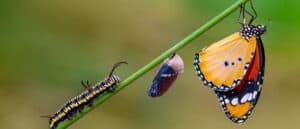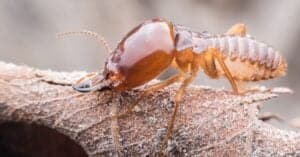Termites and ants are regularly mistaken for the other. But the two species have fewer similarities than they do differences. Keep reading and learn about these creatures in our termites vs. ants comparison.
Termites vs Ants
Here’s a look at both species and their distinctive behaviors.
Ants
There are over 12,000 ants species. These powerful insects are capable of lifting 20 times their body weight. The queens can give birth to millions of babies. As social animals, they live and travel in groups.
The colonies consist of a queen, female workers, and males. Some ant colonies have multiple queens. Though not known for flying, only the males and queens have wings. The male’s responsible for impregnating the ant. Only the queen lays eggs.
Solder ants act as defensive barriers, protecting the colony and guarding the queen. They attack other colonies looking to conquer and take food. The attackers even take the other colony’s eggs and hatch them to become slaves.
Termites
Termites feed on wood. The community’s made up of kings, queens, swarmers, and workers. You differentiate swarmers and workers by noting workers are a cream color. Swarmers reproduce where only queen ants lay eggs. Swarmers may lack wings as the appendages can fall off shortly after emergence.
Termites are detritivores, meaning they feed on wood and tree bark. The insects sustain themselves on cellulose in wood. In some cases, they will eat plants. If in dire need, termites may also feed on plastic, paper, and drywall.
These determined critters burrow deep into wood structures. They are usually discovered after creating significant damage to those structures. Once finding a home, termites quickly settle in. They build what’s called mud tubes. These structures serve as bridges between their food source and colony. Mud tubes protect the colony and conserve moisture. Mature termites will go off to start new colonies.
Comparing Ants vs Termites
The following table compares the two species, highlighting major differences between them at a glance.
| Ants | Termites | |
|---|---|---|
| Behavior | Ants are social animals, members of the Formicidae family. Surprisingly, they’re related to bees and wasps. | Termites are social animals. Part of the Rhinotermitidae family, the closest relative to termites is cockroaches. |
| Appearance | Like all insects, ants have three pairs of legs. Each leg has three joints. They have large, bent antennae, powerful jaws, and compound eyes. They come in black or red. | Termites are soft-bodied with straight antennae. Colors range from light brown to white. Swarming termites are dark and worker termites appear lighter. |
| Colonies | The ant community consists of queens, females, and males. Each group has its specific responsibility. | The termite community is a bit more defined by a caste system. You have workers, soldiers, and swarming termites. |
| Wings | Ants have a set of large forewings and hind wings. | Termites have four wings all the same size. |
| Diets | Ant diets vary in species. Mostly, they feed on seeds, leaves, small insects, honeydew, and nectar. Ants gather food and take it back to the colony. | Termites eat wood as cellulose is critical to survival. But doing so creates significant damage as they burrow into foundations. |
| Behavior | Ants travel in well-organized, almost militant groups. They’re in search of food to take home. Outdoors, you’ll see ants congregating outside of their mounds or foraying boldly. Ants find food with an uncanny sense of smell. It’s no accident that they invade picnics. | It’s rare to actually see termites as they tend to spend their time safe inside mud tubes and their feeding areas. You’re more likely to come across the damage left in their wake first. |
The 6 Key Differences Between Termites and Ants
Ants and termites are often assumed to be the other even though termites are never out in the open. Here are six key differences between termites and ants.
1. Termites vs Ants: Antennae
The ant is the only insect to have elbow-bent antennae. Termites have the usual straight antennae, but they look like they have balls or beads on them.
2. Termites vs Ants: Body Shapes
Ants have narrow bodies, especially around the middle, or waist. Termites tend to have broader waists.
3. Termites vs Ants: Wings
Both termites and ants have four wings. Termite wings are fairly uniform in size. Ants have two small wings on the hindquarters. The forewings are larger. Both insects can lose their wings. Exterminators say homeowners are more likely to discover discarded termite wings before they see the insects themselves.
4. Termites vs Ants: Visibility
The ant ends up in different settings as it forages for sustenance. It’s why you’ll see ants boldly walking across your indoor and outdoor spaces. The most common areas where you’ll find them are on baseboards and window sills. Termites are subterranean. You’ll find signs of their work, such as droppings and wings, but you’ll rarely see termites.
5. Termites vs Ants: Diets
Ants eat a variety of foods, including other insects. Termites are strictly on a wood diet. They do not eat wood though. The insects instead feed on the cellulose in the wood. They shave the wood and extract the compound.
6. Termites vs Ants: Attractants
Ants and termites of all types look for moisture. They both lean toward wood with easy points of entry. Of course, both insects are so tiny, it doesn’t take much for them to find ways to invade our environments.
Termites in Your Home
A terrible fear of homeowners around the globe is termites. These insects can wreak serious havoc on the underlying structure of homes. The bones of most houses are made of wood, termites’ favorite snack. You can tell there is termite damage to a home in a few simple ways:
- Knock on walls to detect hollow spots
- Look for cracks and splits in walls, baseboards, frames
- Swollen floor/wall panels
- Spot droppings – small, wood-colored
- Termite wings lying around
If the infestation becomes overwhelming, you will probably be able to see actual termites scurrying and flying around your home. Getting rid of an infestation can be the most difficult part, even before having to restructure the home. You can set up termite baits, spray for termites, use boric acid spray outside around the home, or have your house professionally tented to remove the insects.
If you live in an area prevalent with termites, always keep an eye out and take care of your home to prevent termite infestations.
Summary: Ants vs Termites
| Ants | Termites |
|---|---|
| Elbow-bent antennae | Straight antennae with ball tip |
| Narrow body | Broad body |
| 4 wings Larger forewings | 4 wings – uniform |
| Forage for food above ground | Subterranean |
| Plant matter, carcasses, other animals | Wood |
| Look for moisture | Look for moisture |
Up Next…
Ants and termites are easily mixed up, something that happens often with insects. Here are a few other examples, including ant species and other insects:
- Fire Ant Mound vs Regular Ant Mound: What are the Differences? – Fire ants and regular ants are very important to tell apart.
- Carpenter Ant Frass vs Termite Frass: Key Differences – Boring insects leave behind telltale signs of their existence called frass. Is it possible to tell these frasses apart?
- Carpet Beetle vs Bed Bug: What are the Differences? – Both are not very pleasant insects to find in your home, this is how you can tell these two apart.
The photo featured at the top of this post is ©
FAQs (Frequently Asked Questions)
Do ants look like termites?
From the human perspective, they do, which is why most of us mix them up. But if you look at pictures of these insects, they have unique characteristics that distinguish the different species.
How do you identify ants versus termites?
Each insect has its body type. But the most obvious distinction is the wingspan and size. Across its species, ants are larger than termites. Ants can be up to 0.03 to two inches in length. Termites generally measure between one-quarter and a half-inch long.
What are the signs of termite infestation?
Keep an eye out for drooping or discolored drywall, peeling paint that might appear to be water damage, wood that makes a hollow sound when tapped, buckling floorboards, and loose tiles from termites adding moisture to walls and floors.
Thank you for reading! Have some feedback for us? Contact the AZ Animals editorial team.





